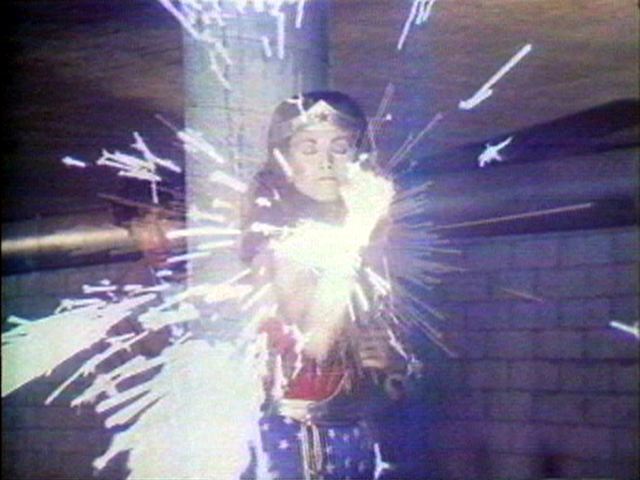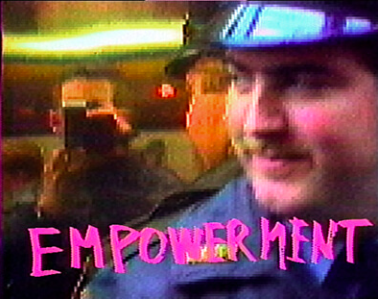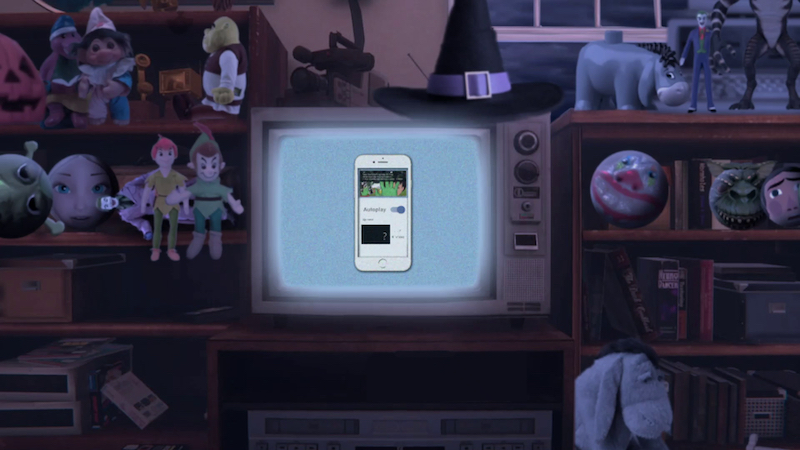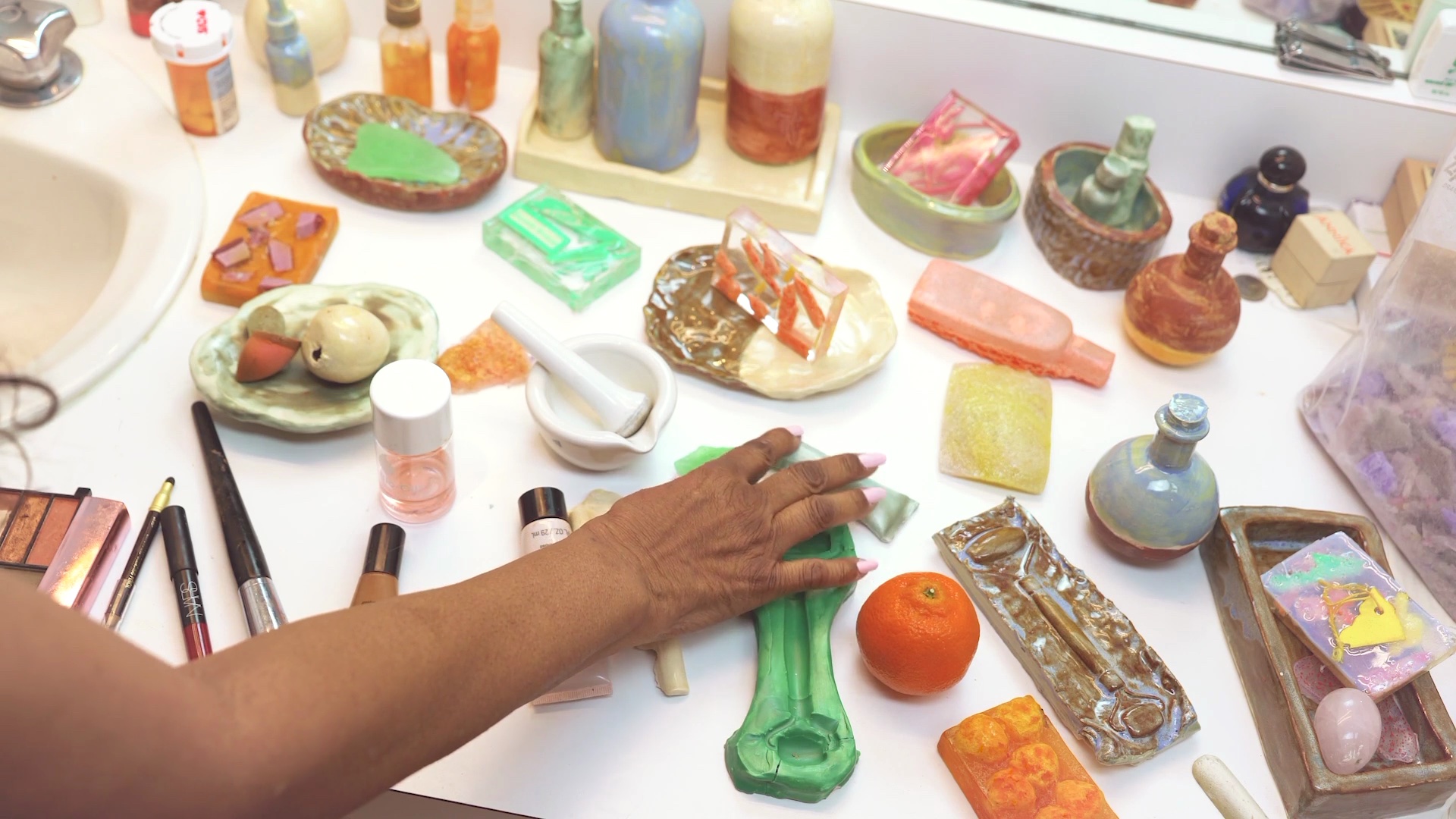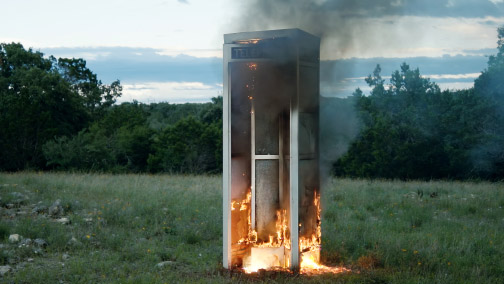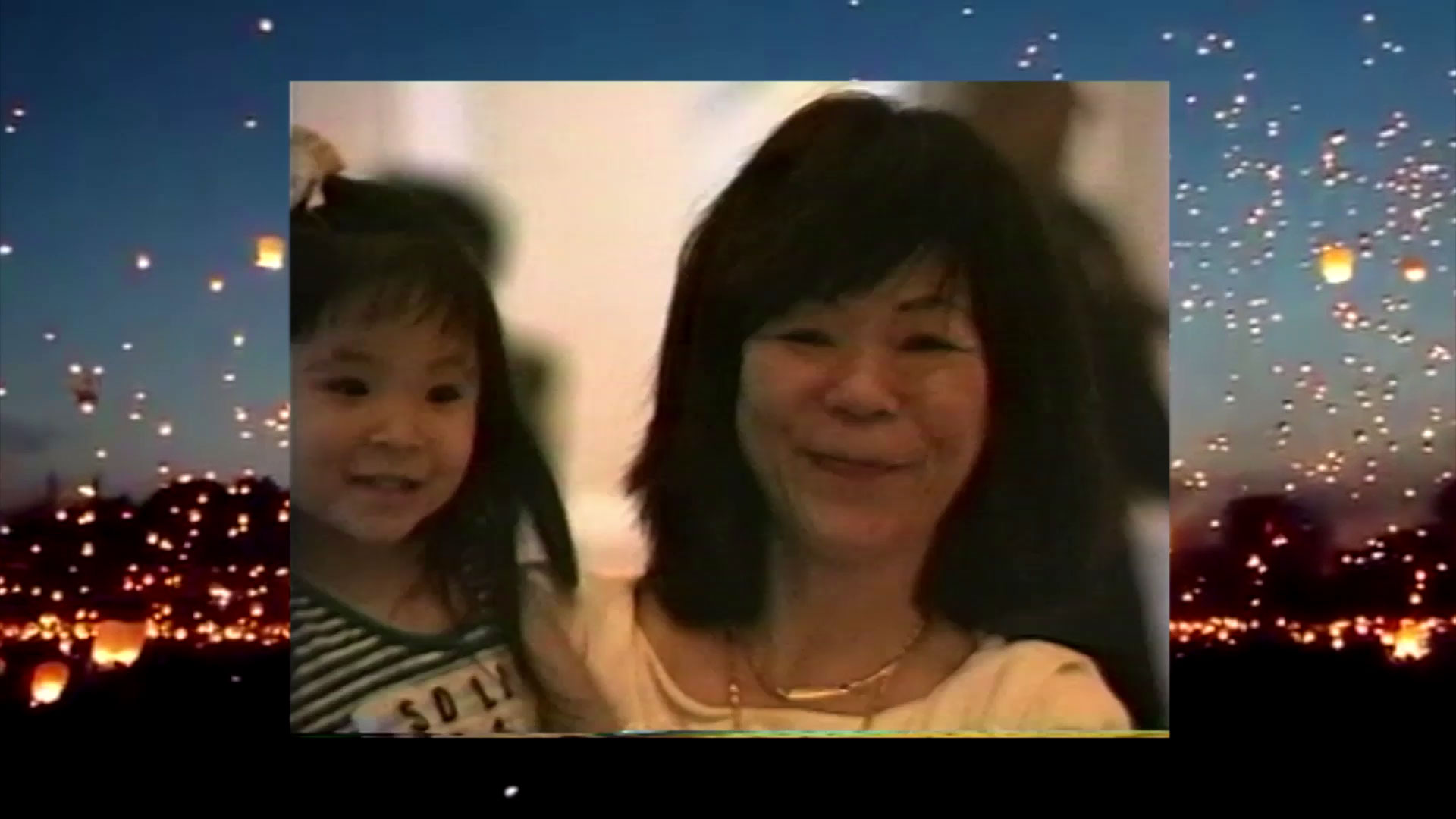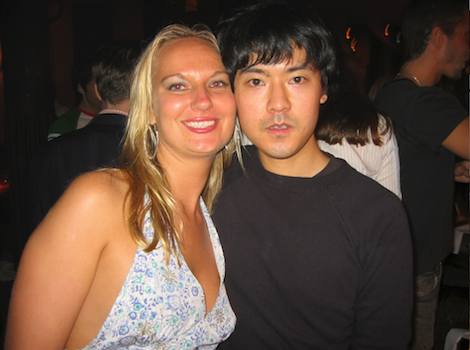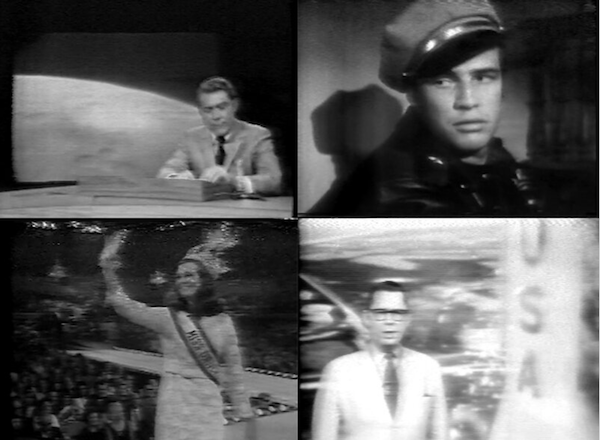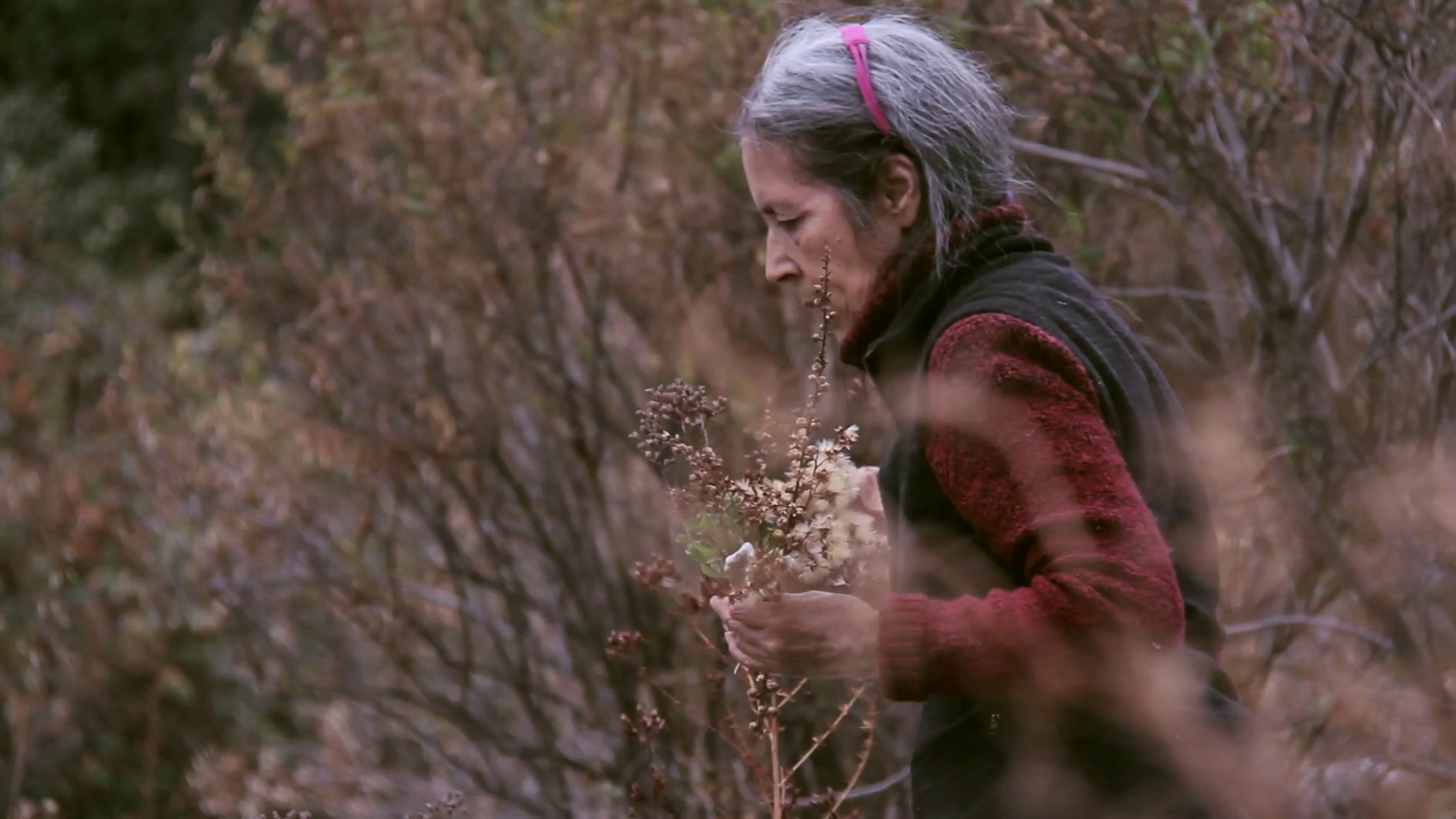The EAI Collection: Featured Artists
Featured Artists
The influential, provocative and often radical art-making practices of Vito Acconci have evolved from writing through conceptual art, bodyworks, performance, film, video, multimedia installation, sculpture, design and architecture. In the 1970s, he produced a remarkable body of conceptual, performance-based film and video works, in which he engages in an intensive psychodramatic dialogue between artist and viewer, body and self, public and private, subject and object.
Over the course of her career, Peggy Ahwesh has produced one of the most heterogeneous bodies of work in experimental film and video. A true bricoleur, her tools include narrative and documentary styles, improvised performance, Super-8 film, found footage, digital animation, and Pixelvision video. With playfulness and humor, she investigates cultural and gender identities, the role of the subject, language and representation.
Ant Farm was an innovative countercultural collective working in media, architecture and spectacle from the late 1960s through the 1970s. Their media events, site structures, performances and videotapes merge an irreverent pop humor with cultural and political critique. Images of a Cadillac crashing through a wall of burning TV sets, or of ten Cadillacs buried, fin-up, in a field off Route 66 in Texas are emblematic of Ant Farm's provocations towards the mass media and American cultural icons.
Eleanor Antin, who has worked in film, video, photography, installation, writing and performance since the 1960s, uses fictional characters, autobiography and narrative to invent histories and explore what she calls, "the slippery nature of the self." In her performance-based video works, Antin uses role-playing and artifice as conceptual devices, adopting archetypal personae — a ballerina, a king, a nurse — in her theatrical dramatizations of identity and representation.
Cory Arcangel is a Norway-based artist who makes work in a wide range of media, including music, video, modified videogames, performance, and the Internet. Arcangel often makes use of appropriation as a strategy, drawing on source materials that range from best-selling albums to Photoshop gradients. His work explores the nature of cultural production and consumption in a media- and technology-saturated world.
Charles Atlas is one of the premier interpreters of dance, theater and performance on video. Working in film, video, installation, theater and performance for four decades, he has created works for screen, stage, gallery, and television. A pioneer in the development of media-dance, he transforms this genre into a provocative and ironic collusion of narrative and fictional modes with performance documentary. He has collaborated with international performers and choreographers, including Anohni, Merce Cunningham, Michael Clark, Leigh Bowery, John Kelly, Karole Armitage and Bill Irwin.
In Alex Bag's ironic performance videos, the artist adopts a series of personae to create droll conceptual parodies. With her signature deadpan delivery and deliberately low-tech style, Bag mixes the vernacular of pop culture with irreverently humorous monologues. Performing in multiple guises amidst fragments of pop detritus, Bag skewers the tropes of consumer and media culture. Questioning how we define ourselves in relation to television, fashion, advertising and the artworld, she creates mediated parodies that teeter between celebration and critique. EAI is pleased to make available, for the first time, Bag's body of video works from the 1990s and 2000s.
John Baldessari has been termed "one of the most influential artists to emerge since the mid-1960s." From his phototext canvases to his composite photo collages and installations, Baldessari's works have contributed to the definition of postmodern art. In the early 1970s, he produced droll conceptual video works that are ironic investigations into perception, meaning and interpretation, rendered with deadpan, often absurdist humor.
Phyllis Baldino engages in a conceptual art practice that merges performance, video, sculpture and installation. With wit and ingenuity, Baldino uses anecdotal conceptual humor and an implied narrativity to question the function and meaning of everyday objects and gestures. These inquiries, which are often informed by scientific or philosophical principles, have in recent years expanded to include investigations into vision and perception.
A pioneeer in video technology and image processing, artist and engineer Stephen Beck developed one of the first video synthesizers—the Beck Direct Video Synthesizer—in 1969. Electronically fusing moving color imagery with recorded visual material in real time, Beck created performance collaborations with musicians. In 1974, he designed the Video Weaver, a digital video computer with "warps" and "wefts" based on traditional textile looms. Beck's pure abstractions of moving light and color represent a fusion of art and technology.
Michael Bell-Smith uses digital forms to explore contemporary visual culture and how it is mediated through popular technologies. His work often incorporates the visual vocabulary of the Internet, such as animated gifs and lo-res images, and references the aesthetics and semiotics of common computer programs such as Powerpoint and Web sites such as YouTube. Remixing and reinterpreting sources ranging from industrial videos and music clips to classic cinema and contemporary art, Bell-Smith reconsiders the cultural meaning of these materials in a "post-personal computer, post-Internet, post-Google" age.
An eminent sculptor and videomaker for more than three decades, Lynda Benglis produced a pioneering body of feminist video in the 1970s. Immediate and visceral, Benglis' video work confronts issues raised by feminist theory, including the representation of women, the role of the spectator, and female sexuality. Benglis also engages the emergent practice of video in an incisive discourse on the production of the moving image.
Since 1994, the anonymous, international group of artists known as Bernadette Corporation has explored strategies of cultural resistance and détournement, appropriating contemporary entertainment modes for their own experimental purposes. From the New York-based BC fashion label, which garnered a cult following in the 1990s, and the magazine Made In USA, launched in 1999, to the collectively-authored novel Reena Spaulings (Semiotexte, 2005) and videos starring the likes of Sylvère Lotringer and Chloe Sevigny, Bernadette Corporation's interventionist projects amount to a precisely-calibrated critique of a global culture that constructs identity through consumption and branding.
As an artist, teacher, and activist, Joseph Beuys is one of the major figures in postwar German art. His theories on the social utility of art influenced a generation of artists. Beuys, who was associated with the Fluxus movement, created conceptual works, objects, drawings, installations, performance "actions" and lectures. These materials featured here chart Beuys' developing relationship with an American audience, from his first tour in 1974 to the 1980s.
Dara Birnbaum's provocative video works are influential and innovative contributions to the contemporary discourse on art and television. In her videotapes and multi-media installations, Birnbaum applies both low-end and high-end video technology to subvert, critique or deconstruct the power of mass media images and gestures to define mythologies of culture, history and memory.
In his body of moving image work that spans the mid-1980s to the present, Robert Beck/ Buck merges cinematic, televisual, and visual art aesthetics and strategies to singular effect, paying careful attention to the viewer's experience of his art. From his conceptual cable access television series of the 1980s through his activist works, "alternative" music videos and found-footage pieces, Beck/Buck's privileging of unexpected interpretations is the heritage of an eclectic list of influences, including Marcel Duchamp and Cady Noland, Robert Bresson and George Romero, film theorist Carol Clover and novelist Cormac McCarthy, the true-crime genre, the teachings of Jacques Lacan, and forensic science.
Chris Burden gained international attention in the 1970s as an influential and often controversial figure in the West Coast body art, performance and conceptual art movements. Investigating the psychological experience of personal danger and physical risk, he used his own body as an art object in outrageous, sometimes shocking acts, aggressively confronting the artist/audience relationship and the artmaking process.
One of the most celebrated and iconoclastic figures of the American musical avant-garde, John Cage has been instrumental in reshaping postwar Western music. Cage's radical innovations in compositions and theory — the application of chance and "found" sound as an integral compositional device, the creation of musical structures based on rhythm rather than tonality — were influential in altering traditional concepts of musical interpretation.
French videomaker Robert Cahen has since 1972 produced works for cinema and television. His fictions and documents are metaphoric voyages or reveries through time, place, memory and perception. Genres such as narrative and performance are expanded through visual, aural and temporal transformations of represented reality.
French conceptual artist Sophie Calle redefines through personal investigation the terms and parameters of subject and object, public and private. In her projects, Calle immerses herself in examinations of voyeurism and identity. Often playing roles or adopting guises, she recasts her own identity to reconstruct or document strangers' lives, examining the relationship between the artist and the objects of her investigations.
Through a multimedia art practice that encompassed drawing, painting, sculpture, photography, video, and film, as well as through her work as a curator and writer, Ellen Cantor (1961-2013) advanced bold new feminist representations of sexuality and female disempowerment and empowerment. With wit and a critical eye, Cantor displays a masterful facility in re-editing appropriated footage, from Disney and The Sound of Music to Antonioni and Cassavetes films, porn, and The Texas Chainsaw Massacre. Through her self-conscious use of consumer video, Cantor both calls attention to the constructed fantasies on screen and heightens an illusion of reality. Integrating Hollywood fairy tale castles, horror movie "final girls," homemade sex tapes, and video diaries into her own "'true' love stories," Cantor troubles boundaries between fiction and life, as well as public and private.
From the mid-1970s until her death at age 31 in 1982, Korean-born artist Theresa Hak Kyung Cha created a rich body of conceptual art that explored displacement and loss. Informed by French psychoanalytic film theory, her video works use performance and text to explore interactions of language, meaning and memory. Cha's posthumously published book Dictée is an influential investigation of identity in the context of history, ethnicity and gender.
The video works of Korean artist Seoungho Cho are distinguished by a lyrical confluence of complex image processing and sound collage. His works are formalist, almost painterly explorations of subjectivity and the subconscious. These poetic meditations often focus on isolation and estrangement in relation to culture and landscape.
Jacob Ciocci was born in 1977 in Lexington, Kentucky. He received a BA in Computer Science and Art from Oberlin College in 2000 and an MFA in Art from Carnegie Mellon University in 2005. Ciocci has had solo exhibitions at Interstate Projects, New York; And/Or Gallery, Los Angeles; Prosjektrom Normanns, Norway; Night Light Gallery and Studios and shown work in collaborative and group exhibitions at Penrith Regional Gallery, Australia; the Migros Museum, Zurich, Switzerland; the Mattress Factory, Pittsburgh; the Pittsburgh Biennale; Cooper Cole Gallery, Toronto, and the Cleveland Museum of Contemporary Art, Cleveland. He has also performed cross-nationally with Extreme Animals at institutions and venues including the Museum of Modern Art, New York; the New Museum, New York and the Hirshhorn Museum, Washington DC. Ciocci lives and works in Chicago, IL.
Tony Cokes investigates identity and opposition through reframing and repositioning. He questions how race and gender influence the construction of subjectivities, and how they are perceived through "representational regimes of image and sound" as perpetuated by Hollywood, the media and popular culture. His assemblages of archival footage, media images, text commentary, and pop music use sources ranging from Louis Althusser, Malcolm X and Public Enemy.
Jaime Davidovich was a conceptual, video and installation artist, as well as a pioneering activist for the potential of artist-run, local cable television programming. Davidovich was a founding member of Cable SoHo (1976) and president of the Artists' Television Network (1978). His own cable access show, a weekly variety program called The Live! Show, aired on Manhattan Cable Television from 1979 until 1984. In the guise of his alter-ego, Dr. Videovich, Davidovich hosted the show, which featured performances by and interviews with art world personalities, live phone-ins and a home-shopping segment from which he sold his collection of TV-related kitsch.
Video has been central to Cheryl Donegan's art since the early 1990s, when she burst onto the scene as part of a generation of artists, many of whom are women, developing a new conceptual art practice. Donegan's work integrates the time-based, gestural forms of performance and video with forms such as painting, drawing, and installation. Provocative and irreverent, her body-based, performative video works put a subversive spin on issues relating to sex, gender, art-making, art history, and pop culture.
Jean Dupuy started his artistic career as a painter but shifted his practice when he moved from France to New York in 1967. Dupuy experimented with new technologies and was a prominent figure in the Art and Technology movement. In the early 1970s he started performing collectively with New York artists, and became known as an organizer of and participant in downtown performance events.
VALIE EXPORT has been an influential and provocative figure on the international art scene for over three decades. Her practice includes film, video, photography, text and performance. Initially expanding the Viennese Actionist project to confront a complex feminist critique of the social and political body, her works achieve a compelling fusion of the visceral and the conceptual.
Forcefield, an artist collective from Providence, Rhode Island, has forged an interdisciplinary practice that includes music, performance, installation, textiles, printmaking, and video. Oscillating between humor and menace, their willfully crude videos employ vintage analogue signal-processors and defunct electronics, the anonymous artists shrouded in knit outfits. Collapsing the neo-primitivist and the futurist, Forcefield's patchwork aesthetic suggests the detritus of the post-nuclear future, the recent past, and the post-industrial present.
Terry Fox was a central participant in the West Coast performance, video, and Conceptual Art movements of the late 1960s and early 1970s. His performance actions explore ritual and symbolic content in the objects, places, and natural phenomena of everyday life. In the 1974 Children's Tapes, a classic early work, Fox uses the intimate scale and real-time properties of video to enact a conceptual performance of everyday objects.
The artist collective General Idea — AA Bronson, Felix Partz and Jorge Zontal — forged a unique conceptual practice that deployed parody and irony to critique the artworld and popular media culture. In performances, installations, video, photography, prints, and editions, they explored social phenomena ranging from the production, distribution and consumption of mass media images to gay identity and the AIDS crisis. General Idea worked together from 1969 until the deaths of Partz and Zontal in 1994.
French filmmaker Jean-Luc Godard is one of the essential figures in modern cinema. In 1976, Godard began collaborating with filmmaker Anne-Marie Miéville on a series of radically innovative works for broadcast on European television. Displaying the rigorous intellect and irreverent wit that characterize Godard's films, these richly experimental works break new ground both as video and as television.
Dan Graham's provocative art and theories analyze the historical, social and ideological functions of contemporary cultural systems, including architecture, rock music, and television. In performances, installations, and architectural/sculptural designs, he investigates public and private, audience and performer, objectivity and subjectivity. Deconstructing the phenomenology of viewing, he manipulates perception with time delay, projections, closed-circuit video, and mirrors.
With a career spanning fifty years, Barbara Hammer is recognized as a pioneer of queer cinema. A visual artist working primarily in film and video, Hammer created a groundbreaking body of experimental work that illuminates lesbian histories, lives and representations. Stated Hammer, "My work makes these invisible bodies and histories visible. As a lesbian artist, I found little existing representation, so I put lesbian life on this blank screen, leaving a cultural record for future generations."
Ilana Harris-Babou is a multimedia artist whose video works are an important component of a practice that includes sculpture and object making, performance, and installation. In her projects, Harris-Babou mines the aesthetics of YouTube tutorials, home improvement and cooking shows, and corporate ad campaigns to call attention to how personal and social identities are constructed—and co-opted—by dominant ideologies.
Frank Heath was born in 1982 in St. Joseph, Missouri. He has exhibited his work in solo shows at the Simone Subal Gallery, New York and collaboratively at the Swiss Institute, New York; Young World, Detroit; Simone Subal Gallery, New York; Art Basel Statements, Basel; and the Videotage Gallery, Hong Kong. His work has exhibited in group shows and screenings at venues including the Kitchen, New York; International Film Festival Rotterdam, the Power Plant, Toronto; Centre Pompidou, Paris, and the High Line, New York. Heath currently lives and works in New York City.
Gary Hill is one of the most important contemporary artists investigating the relationships between words and electronic images. His inquiries into linguistics and consciousness offer resonant philosophical and poetic insights, as he explores the formal conjunctions of electronic visual and audio elements with the body and the self. With experimental rigor, conceptual precision and imaginative leaps of discovery, Hill's work in video is about, and is, a new form of writing.
A pioneer of earthworks and public art, Nancy Holt also worked in sculpture, installation, film, video, and photography for over three decades. She is best known for her large-scale environmental sculptural works, including Sun Tunnels in Utah and Dark Star Park in Virginia. In the late 1960s and early 1970s, Holt made a series of pioneering film and video works, including several collaborations with Robert Smithson. Holt's early videos explore perception and memory through experiments with point of view and process.
Ken Jacobs is an essential figure in the history of American avant-garde film. A leader in cinematic and now digital experimentation since the late 1950s, he explores the mechanics of the moving image and the very act of viewing. Jacobs investigates the cinematic experience in its entirety, from production to projection. Whether undertaking archaeological journeys to the dawn of cinema or scrutinizing the interstices of new digital technologies, Jacobs' work investigates, provokes, and draws power from the mysteries of the nature of human vision.
Ulysses Jenkins’s video and media work is remarkable for its fusion of forms to conjure vibrant expressions of how image, sound and cultural iconography inform representation. Beginning as a painter and muralist, Jenkins was introduced to video just as the first consumer cameras were made available to individuals, and he quickly seized upon the television technology as a means to broadcast alternative depictions of African and Native American cultures—his own heritage—citing the catalyst of Melvin Van Peebles’s Sweet Sweetback’s Baadasssss Song (1971) and its call to black filmmakers to control their subject-hood by controlling the media depicting them.
Internet provocateurs JODI pioneered Web art in the mid-1990s. Based in The Netherlands, JODI (Joan Heemskerk and Dirk Paesmans) were among the first artists to investigate and subvert conventions of the Internet, computer programs, and video and computer games. Radically disrupting the very language of these systems, including interfaces, commands, errors and code, JODI stages extreme digital interventions that destabilize the relationship between computer technology and its users.
An acclaimed multi-media performance artist, Joan Jonas is also a major figure in video art. From her seminal performance-based exercises of the 1970s to her later televisual narratives, Jonas engages in an elusive theatrical portrayal of female identity. Employing an idiosyncratic vocabulary of ritualized gesture and symbolic objects that include masks, mirrors, and costuming, she explores the self and the body through layers of meaning.
Philip Mallory Jones explores the emerging global African diaspora culture and consciousness through nonverbal storytelling and an evocative, transcultural language of sound and image construction. Jones merges experimental narrative and subjective documentary forms to synthesize what Jones terms the "realities of African culture and my own emotional and metaphysical odyssey."
Stanya Kahn is an interdisciplinary media artist. Working primarily in video, with a practice that includes performance, writing, and photography, Kahn's work inhabits a space between fiction and document, and stems from an extensive background in live performance. Integrating the visceral and the improvised with the tightly scored and written, her work addresses issues of agency, power, and the uses and failings of language. Kahn's kinetic relationship to the performative and to humor inform a hybrid media practice infused with pop vernacular, documentary tropes and experimental film/video praxis.
Tom Kalin's works traverse diverse genres and forms, from independent feature films to video poems. A prominent figure in the New Queer Cinema, he was a founding member of the AIDS activist collective Gran Fury. Swoon (1992), his first feature film, typifies his mix of narrative, cultural theory and social awareness. His resonant video works, which merge text, music, and poetic images, fuse the personal with the political.
Mike Kelley was one of the most provocative and influential figures in contemporary art. His idiosyncratic works negotiate a charged terrain of desire, dread and sociopathology in everyday life. With deadpan humor, he invests childhood toys, kitsch, and ordinary objects with subversive meaning. His video projects, often created with collaborators such as Paul McCarthy, Raymond Pettibon, and Tony Oursler, inhabit a peculiarly American landscape infused with irony and pop cultural debris.
German filmmaker Alexander Kluge, one of the most innovative and intellectual figures in contemporary German cinema, has produced a remarkable series of works for television. Traversing realms of desire and culture in the 19th and 20th centuries, these experimental works weave together eclectic references — advertising, cinema, opera, communications — to construct an ironic critical discourse on fantasy, representation, and history.
Ken Kobland has produced independent film and video works since the 1970's, including collaborative projects with the experimental theater company The Wooster Group. Through metaphor, provocation and association, Kobland often explores the historical meaning, critical context, and received notions of a particular place, in sites ranging from Moscow to Shangai.
Shigeko Kubota brought a singular sensibility to her extensive body of video sculptures, multi-media installations, and single-channel videos. Over her five-decade career, Kubota forged a lyrical confluence of the personal and the technological, often merging vibrant electronic processing techniques with images of nature, culture, art and everyday life. A prominent Fluxus artist in the 1960s, she also created an idiosyncratic video diary that spanned the 1970s to the mid-2000s.
George Kuchar was a legendary figure in the underground film scene. Raw and often outrageous, his low-tech video diaries chronicle an ongoing personal history. Kuchar's eccentric presence pervades these "home videos," which veer from the scatological to the sublime as they observe the banality and intimacy of the everyday. With perverse humor and melancholy, his video journals resonate with an unexpected poetry.
Working primarily in film, video, and performance, Andrew Lampert pursues the alchemy between artist, art, and audience in a public space, especially that of cinema. A trained film archivist, Lampert combines a Duchampian attention to the gap between an artwork's private intent and public reception with an appreciation for the contingency of film as a medium, bringing unscripted and chance elements into cinema's veneer of control. Reveling in cinema as a performative environment, Lampert reclaims this space from a mass media culture to emphasize its potential for immediacy and accident.
Maggie Lee's work has taken shape in a wide array of forms including sculpture, installation, photography, zine-making, blogging and moving image. Her videos often oscillate between the personal and the pop-cultural, blending diaristic self-documentation with collaged found sound and image. Lee’s work probes the emotional undercurrents and personal resonances of contemporary culture: memories of the artist’s early years in suburban New Jersey, candid scenes from New York City nightlife, and totem-like odes to the assorted mass-produced ephemera that adorns daily life.
In a multidisciplinary practice that includes videos, performances and music, Kalup Linzy creates satirical narratives inspired by television soap operas, telenovelas and Hollywood melodramas. Taking an irreverent approach to stereotypes of race, gender and sexuality, Linzy performs, most often in drag, in a series of memorable recurring roles. The artist serves as writer, director, cinematographer, editor, and actor—and, in a distinctive strategy, also voices and overdubs the dialogue of multiple characters. At once comic, raunchy and poignant, Linzy's unique narrative videos fuse theatrical intensity with melodramatic irony.
Tali Hinkis and Kyle Lapidus began collaborating as LoVid in 2000. An alchemy of independent interests in technology has defined LoVid's aesthetic, combining craft-oriented analog processes and playful engineering with natural and social science. LoVid's live performances, participatory public art works, immersive installations, and video and textile projects express the radiant noise of an electrified but human world.
Kristin Lucas is a multidisciplinary artist working in video, installation, live, networked, and hybrid media art forms. In works that gain their currency within the context of public and private systems, Lucas responds to the uncanny overlaps of virtual and lived realities, and to the fast-changing mediascape that reconfigures perception and identity. Lucas critically engages with the tools she investigates, re-imagining and re-contextualizing their use in a way that looks to technology to provide new platforms for social and community engagement.
Exploring light and landscape as agents of visual perception and memory, Mary Lucier examines 19th-century art historical and literary traditions through the lens of technology. In elegant "pictorial-narrative" works, she investigates the American pastoral myth in "an ironic dialogue between past and present, mundane and poetic, real and ideal." Lucier's metaphoric use of light evokes transcendence and the sublime.
French filmmaker Chris Marker was one of the most highly regarded and experimental figures in cinema. His 1962 film La Jetée is a recognized classic. Marker also worked in video and interactive technologies, creating documentaries, poetic meditations, and idiosyncratic essays.
Gordon Matta-Clark's thoroughly unique artistic project was a radical investigation of architecture, deconstruction, space, and urban environments. Dating from 1971 to 1977, his most prolific and vital period, his film and video works include documents of major pieces in New York, Paris and Antwerp, and are focused on three areas: performances and recycling pieces; space and texture works; and his building cuts.
Los Angelean Cynthia Maughan produced nearly 300 videos from 1973 to 1980, creating mostly short, direct-camera performances in which she stars in scenarios borrowed from a range of cinema and television sources. The dry wit and pictorial economy of her works also shows the influence of then contemporary California artists working in video, such as William Wegman, Paul McCarthy and Martha Rosler. Absorbing Hollywood's beguiling superficiality, Maughan treats the closed-circuit camera as a two-way mirror, in which and for which she prepares her public persona.
McCarthy was an influential figure in the Southern California art and performance scene for decades before achieving international recognition. His performance work in the late 1970s explored areas of Dionysian and shamanistic initiation rituals, as well as the body and sexuality. The intensity of these performances, which often included the graphic depiction of taboo subjects, eventually led to his use of video and installation as primary media.
Described by composer Edgar Varese as "the Jeanne d'Arc of new music," Charlotte Moorman was a central figure of the New York avant garde of the 1960s and '70s. In 1963 she established the Annual Avant Garde Festival in New York, which she directed for two decades. As a performer, she was a longtime collaborator of Nam June Paik, who created many of his best-known pieces for her, including TV Bra for Living Sculpture (1969) and TV-Cello(1971).
Shana Moulton creates evocatively oblique narratives in her video and performance works. Combining an unsettling, wry humor with a low-tech, Pop sensibility, Moulton plays a character whose interactions with the everyday world are both mundane and surreal, in a domestic sphere just slightly askew. As her protagonist navigates the enigmatic and possibly magical properties of her home decor, Moulton initiates relationships with objects and consumer products that are at once banal and uncanny.
Antoni Muntadas has produced a body of work across diverse media, including photography, video, publications, the Internet, multimedia installations and urban interventions. In his projects, Muntadas addresses social, political and communications issues, the relationship between public and private space within social frameworks, and investigations of channels of information and the ways they may be used to censor information or promulgate ideas.
Takeshi Murata produces extraordinary digital works that refigure the experience of animation. His innovative practice and evolving processes range from intricate computer-aided, hand-drawn animations to exacting manipulations of the flaws, defects and broken code in digital video technology. Whether altering appropriated footage from cinema (B movies, vintage horror films), or creating Rorschach-like fields of seething color, form and motion, Murata produces astonishing visions that appear at once seductively organic and totally digital.
In writing, performance and visual art that incisively satirizes pop culture and the art world, Jayson Scott Musson provokes the boundaries that define cultural and racial stereotypes. His most well-known creation is the "art critic" Hennessy Youngman, whose episodic Internet talk show Art Thoughtz has become a viral video phenomenon. In the guise of Hennessy Youngman, Musson uses hip-hop vernacular to critique the exclusionary language of art discourse, hilariously pitting hip-hop and art world idioms against each other in a dual parody of cultural clichés. Engaging hybrid media and contexts, Musson uses platforms such as YouTube to circumvent traditional art institutions and reach a mass audience on his own terms.
Bruce Nauman is one of most important and influential figures in contemporary art. His seminal films and videotapes from the 1960s and '70s are among the most innovative contributions to media art. In these conceptual works, Nauman uses his body as an art object, executing repetitive performance actions in his studio. Exploiting the phenomenology of the medium, including its immediacy, space, and intimacy, his real-time gestures investigate the very process of making art.
Tony Oursler's video and multimedia works take the form of a low-tech, expressionistic theater that is singular in contemporary art. Willfully primitive, often grotesque, and crafted with an ingenious handmade sensibility, his psychodramatic landscapes are fabricated within the ironic vernacular of pop culture. His idiosyncratic fictions are bizarre narrative odysseys through psychosexual delirium and the detritus and artifacts of mass culture.
Korean-born artist Nam June Paik was a seminal figure in video art. His video sculptures, installations, performances and single-channel videos encompassed one of the most influential bodies of work in electronic media art. Merging global communications theories with an irreverent Fluxus sensibility, his work in music, performance and video explored the juncture of art, technology, and popular culture. Paik, who is recognized as a visionary artist of the international avant-garde, died in 2006.
Charlemagne Palestine is an influential composer, performer and visual artist. In the 1970s, Palestine produced a seminal body of performance-driven, psychodramatic video works in which he ritualistically used physicality, motion and sound to achieve an outward articulation of internal states. Intense and often violently charged, these exercises are characterized by a visceral enactment of physical and psychological catharses.
Artist collective Paper Rad synthesizes popular material from television, video games, and advertising, reprogramming these references with an exuberantly neo-primitivist digital aesthetic. As member Jacob Ciocci writes, "In the '70s and '80s cartoons and consumer electronics were bigger and trashier than ever and freaked kids out... Now these kids are getting older and are freaking everybody else out by using this same throw-away trash."
Alix Pearlstein's performance-based videos function as abstract dramas, operating in a realm between the theatrical and the cinematic. With deadpan humor and a minimalist aesthetic, she employs stylized gestures, role-playing and pop cultural references to create narrative meaning, or uses actors to examine group dynamics and social constructs. Exploring performative strategies, these works, often set in an indeterminate void, condense psychological narrative to expose heightened realities.
Raymond Pettibon's work, including his idiosyncratic pen and ink drawings, juxtaposes an aggressive rawness with an oddly poetic, even metaphysical, sensibility. Pettibon's deliberately crude, low-tech video narratives are irreverent tales of 1960s and '70s West Coast radical subcultures, from Patty Hearst and the Manson family to the Los Angeles punk rock scene. These wildly ironic, deadpan dramas feature an ensemble of luminaries from L.A.'s post-punk underground.
In a conceptual, multi-disciplinary art practice that includes video, sculpture, and what he has called "redistribution," involving sound, music, and written texts, Seth Price engages in strategies of appropriation, recirculation and packaging to consider issues of cultural production and the distribution of information. Shifting and manipulating the detritus of commodity culture, his projects have included early sampler-based academic music, anonymous Internet-circulated video, and art historical imagery. Investigating the cultures generated and re-circulated by mass media technologies and information systems, Price ultimately questions the production and dissemination of art and meaning itself. He is also part of the Continuous Project collective.
Radical Software Group is a loosely defined ensemble of artists and programmers, working collaboratively in digital media. Radical Software Group, or RSG (named for Radical Software, the seminal 1970s magazine), has focused on network environments and interface design, including the award-winning software tool Carnivore.
Pioneering performance and media artist Anthony Ramos was among the earliest video artists to use the medium as a tool for a critique of the mass media, and for giving agency to marginalized communities and individuals. In his powerful but rarely seen video works of the 1970s, Ramos sought to combine art and activism, the political and the conceptual. His video works and performances often reference his time in prison for draft resistance during the Vietnam War.
Pipilotti Rist burst onto the international art scene with visually lush video works and multimedia installations that explore female sexuality and media culture, remixing fantasy and the everyday. In the 1980s and '90s the Swiss-born Rist made a series of tapes in which she subverted the form of the music video to explore the female voice and body in pop cultural representations, merging rock music, electronic manipulation, and performance.
In her work in video, photo-text, performance, critical writing and installation, Martha Rosler constructs incisive social and political analyses of the myths and realities of contemporary culture. Articulated with deadpan wit, her video works investigate how socioeconomic realities and political ideologies dominate ordinary life. Presenting complex critical analyses in accessible forms, Rosler's video works merge performance, narrative, documentary, and mass media images.
Jacolby Satterwhite is a multi-disciplinary artist who uses video, performance, 3D animation, drawing, fibers and printmaking to explore themes of memory, desire, and personal and public mythology. In his video works, Satterwhite creates fantastical digital landscapes populated with multiple, costumed avatars of himself, engaging with hand-drawn objects and text as extensions of the body, in a seamless exchange between live performance and constructed worlds. Satterwhite's computer-generated realms—densely layered with proliferating drawings, objects and performances—encompass animated narratives of personal memory and identity.
Carolee Schneemann, a groundbreaking performance and multidisciplinary artist, has used film and video since the 1960s. Shattering taboos and redefining the notion of the erotic, she confronts sexuality, gender, and the social construction of the female body. Her seminal performances of the 1970s were as transgressive as they were influential. Schneemann continues to provoke, as she explores female sexuality in relation to art-making, ritual, and culture.
Richard Serra is an American artist known for his large-scale sculptures made for site-specific landscape, urban, and architectural settings. From 1968 to 1979, Serra made a collection of films and videos, collaborating with Joan Jonas, Nancy Holt, Robert Fiore, and Carlota Fay Schoolman. Although he began working with sculpture and film at the same time, Serra did not extend sculptural problems into his films and videos, recognizing instead the different material capacities of each.
Stuart Sherman's influential art practice defies classification. Celebrated as an avant-garde performer, he also worked in film, video, and other visual arts, in addition to writing plays and poems. Sherman was an iconoclastic builder and manipulator of mass-produced bric-a-brac; he used an intuitive logic to purposefully transform objects into rhetorical questions. He developed these manipulations into an idiosyncratic performance style that was quick-paced and conceptually witty. The culminating tableaux, featuring Sherman and disassembled or repurposed objects, evoke Rene Magritte, Buster Keaton, and Samuel Beckett.
Trevor Shimizu has produced a large body of paintings that are crudely gestural and sparse, and subtle in their compositional aesthetics if not in their subject matter. In works that are semi-autobiographical, humiliating social incidents and aberrations usually kept private are made public. Alongside his painting practice, Shimizu has produced a body of video art that emphasizes how his personal and public identities have been shaped by home video and the banality of television and media consumerism. As a former Technical Director of Electronic Arts Intermix, he developed close friendships and collaborations with artists including Dan Graham, Carolee Schneemann, Shigeko Kubota, and Dara Birnbaum. The influence of other EAI artists, especially the droll, self-depricating humor of Michael Smith, and Mike Kelley’s unflinching portrayals of American culture, is also clearly evident.
Interweaving documentary, essay, and fiction, Shelly Silver explores how we negotiate cultural and popular narratives to arrive at definitions of the self. She examines storytelling and role-playing to reveal how identity is both reflected and constructed by television and cinema. As an "outside observer" living in Germany, France, and Japan, she questions the myths and realities of cultural and national identity.
Michael Smith is a video, installation and performance artist who invokes the routines of popular comedy to articulate the banality and hype of mass consumer culture, and the isolation of those whose inner lives are defined by it. Smith chronicles the trivial dreams and adventures of his eponymous alter-ego, the deadpan "Mike," a postmodern Everyman who believes everything and understands nothing in his media-saturated world.
Robert Smithson is recognized as one of the most influential artists of the twentieth century. Smithson, who was born in 1938 and died in 1973, was a seminal figure in the art form that became known as earthworks or land art. He radically redefined notions of sculpture through his writings and projects. Among his most important and well-known works are Spiral Jetty (1970), a monumental earthwork located in the Great Salt Lake, Utah, and Partially Buried Woodshed (1970) at Kent State University in Ohio. Smithson's critical writings have had an equally profound impact on contemporary art and theory.
Michael Snow is recognized as one of the most important experimental filmmakers, as well as an accomplished visual artist and musician. His groundbreaking and influential 1967 film Wavelength is a key work in the history of structuralist cinema. In recent years Snow had been working with digital media, exploring electronic processes to further his rigorous investigations into the nature of representation and perception.
Aldo Tambellini was born in 1930 in Syracuse, New York. He received a BFA in Painting from the University of Syracuse in 1954 and an MFA in Sculpture from the University of Notre Dame in 1958. Tambellini was also a fellow at the MIT Center for Advanced Visual Studies from 1976 to 1984. He has had solo exhibitions at institutions including the Museum of Modern Art, New York, and The Whitney Museum. Tambellini’s work has been highlighted in several major retrospective exhibitions including at the Center for Art and Media, Karlsruhle, Germany, in 2017; the Tate Modern, London, in 2012; and the Pierre Menard Gallery, Cambridge, in 2009. Tambellini also has an extensive archive of poetry collected alongside other works by the Tate, United Kingdom and the Albright-Knox Art Gallery, Buffalo, New York. Selected poems, written from 1946 to 2016, were published under the title LISTEN by Grady Miller Books in 2017. Tambellini lived and worked in Cambridge, Massachusetts until his death in 2020.
Refracted through archival material, texts, found footage and dense soundtracks, Leslie Thornton's rigorously experimental film and video work is an investigation into the production of meaning through media. Her epic project Peggy and Fred in Hell is an ongoing cycle of interrelated films, videos and installation environments. Exploring the aesthetics of narrative form as well as the politics of the image, Thornton forges a unique and strangely beautiful syntax, one that poses its critique at the same time that it mesmerizes and confounds.
Adopting the tongue-in-cheek appellation Top Value Television, the influential video collective TVTV defined the radical video documentary movement of the 1970s that is known as "guerrilla television." TVTV subverted conventions of television news and documentary reportage with its alternative journalistic techniques, countercultural principles and pioneering use of portable, low-tech video equipment.
A pioneer in the development of experimental film and live-action animation techniques, Stan VanDerBeek was a visionary of avant-garde and expanded cinema. Advocating a utopian fusion of art and technology, he produced theatrical, multimedia experiments that included projection systems, dance, planetarium events and the exploration of early computer graphics and image-processing systems.
Cecilia Vicuña is a poet, performer, and sound and visual artist, who coined the concept of arte precario (or "precarious art") in the 1960s in response to pressing concerns of the modern world, including ecological destruction, human rights, and cultural homogenization. Born and raised in Santiago, she was exiled during the early 1970s after the violent military coup against President Salvador Allende. This sense of impermanence, and a desire to preserve and pay tribute to the indigenous history and culture of Chile, especially the Quipu (an Andean writing system or "knot-record" fashioned from string), have characterized her work throughout her career.
Bill Viola is a major figure in video art. His works, which have received international recognition, are distinguished by a confluence of allegorical resonance and virtuosic control of technology. Viola explores video's temporal and optical systems to metaphorically examine modes of perception and cognition, and ultimately chart a symbolic quest for self. His ritualized investigations of visual and acoustic phenomena, illusion and reality, achieve a poetic articulation of visionary transcendence.
William Wegman is widely known for his work in photography, painting, drawing and video. A postmodern, conceptual humorist, he was termed a "master of whimsy, whose [works] have a charm and absurdist intelligence sometimes worthy of Beckett," by The New Yorker. Best known for his portraits of his Weimeraner dogs, Wegman created a series of comedic, performance-based tapes in the 1970s. Featuring his dog Man Ray, these droll anecdotes remain video classics.
A key figure in Conceptual Art, Lawrence Weiner has long pursued inquiries into language and the art-making process. From his pioneering installation works of the 1960s and '70s through his new digital projects, Weiner posits a radical redefinition of the artist/viewer relationship and the very nature of the artwork. Translating his investigations into linguistic structures and visual systems across varied formats and manifestations, Weiner has also produced books, films, videos, performances and audio works.
In the 1970s and early '80s, Hannah Wilke produced performance tapes that examine sex and sexuality, feminism and femininity, the body and its representation. Wilke explores gesture in relation to gender and power, using her own image to confront the erotic representation of the female body in art history and popular culture.
The Wooster Group is an ensemble of artists who, under the direction of Elizabeth LeCompte, have collaborated on the development and production of theater, film and media pieces. Considered America's leading experimental theater group, the New York-based Group is renowned for its complex and compelling "televisual" stage productions. The Wooster Group's core members include Jim Clayburgh, Willem Dafoe, Spalding Gray, Elizabeth LeCompte, Peyton Smith, and Kate Valk.
Jud Yalkut (1938-2013) was a pioneering intermedia artist and filmmaker. His remarkable body of moving image work, which spanned fifty years, ranged from early performance renderings and poetic filmic experiments to a series of groundbreaking hybrid video-film collaborations with Nam June Paik. Transcending and transforming media as he explored and merged film, video, expanded cinema, electronic manipulations, performance and installation, he created and collaborated on seminal intermedia projects with numerous artists, filmmakers, musicians and performers. Yalkut was also active as a teacher, curator and writer; his 350-page manuscript Electronic Zen is an essential cultural history of the nascent alternative video scene.
C. Spencer Yeh is recognized for his interdisciplinary activities and collaborations as an artist, composer and improviser, as well as his music project Burning Star Core. Much of Yeh's video work engages with avant-garde composition and performance, variously as studies in form and technique, or as documentation of other artists working within his musical, geographic or social spheres. Other projects are humorously charged excursions into pop and trash cultural anthropology within "tape trading"-style distribution, such as applying highly polished treatment to bootleg video sources or canned pop songs. Pitched at the turn-of-the-millennium transition from "IRL" trades of prized physical objects to BitTorrent file transfers, this aspect of Yeh's work engages questions of value, authenticity, access, and social interactions within shifting paradigms for (unauthorized) circulation of images.
California-based artists Bruce and Norman Yonemoto deconstruct and rewrite the hyperbolic vernacular with which the mass media constructs cultural mythologies. Ironically employing the image-language and narrative syntax of popular forms, such as soap opera, Hollywood melodrama and TV advertising, they work from "the inside out" to expose the media's pervasive manipulation of reality and fantasy.






















